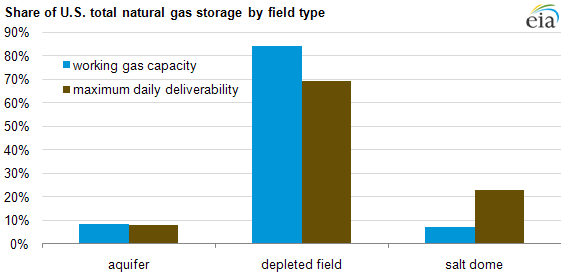
Salt caverns account for 23% of U.S. underground natural gas storage daily deliverability

Download CSV Data
The U.S. has three primary types of underground natural gas storage facilities: depleted fields, aquifers, and salt caverns. Depleted natural gas fields provide by far the largest share of natural gas storage capacity and together with aquifer storage are used primarily to meet seasonal delivery needs. Most new storage facilities built since 2007 have been salt caverns. Salt caverns, which are largely located in the producing region, represent a rapidly growing share of U.S. natural gas storage deliverability. Although salt caverns account for only 7% of total working natural gas capacity, they can be rapidly cycled and deliver up to 23% of total natural gas from underground storage on a given day.
Salt cavern storage has several advantages.
- Flexibility. Salt cavern facilities operate under very high pressure, which means they can quickly accept (inject) or deliver large amounts of gas to the pipeline grid (deliverability). As a result, these facilities are well-suited to meeting short-term changes in demand or supply.
- Cycling. Salt cavern operators can move natural gas in and out of these facilities more frequently, usually up to 6-12 cycles per year, compared to traditional, seasonal gas storage where customers inject in the summer and withdraw in the winter.
- Requires less base natural gas. Salt cavern storage needs less base gas (the permanent inventory needed just to maintain adequate operational pressure) and has a higher proportion of "working gas," the gas that can be accepted from or delivered to customers. This lower base requirement partially offsets the higher capital costs associated with salt cavern facilities.
Salt cavern construction is relatively expensive and differs from the conversion of depleted fields and aquifers. To start, an operator locates a suitable salt bed (typically, wide and shallow salt formations found in Northeastern, Midwestern, and Southwestern states) or salt dome (typically, very deep salt formations that are usually less than one mile in diameter found in Gulf Coast states). The operator then excavates the site to form a cavern, usually by pumping highly-pressurized water into the salt layer to dissolve the salt and create a cavern (often called cavern leaching or solution mining). After leaching, the operator can remove the brine and commence operations.
Salt caverns differ from other storage options in that the salt walls and cap of the caverns are impermeable under higher pressures. In addition, if excavated to a certain depth, geologic pressure can help a storage cavern to be "self-healing," allowing any cracks that may occur to seal quickly.
Tags: natural gas, storage